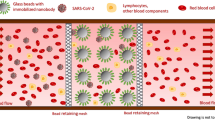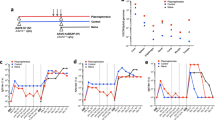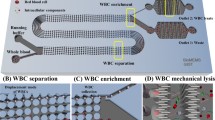Abstract
Heparin covalently attached to a water-insoluble resin suspended in HIV-infected aqueous buffer or whole blood captures the virus; subsequent physical separation of the immobilized heparin reduced the viral titers by over 80 and 50%, respectively. The detoxification concept has been validated by both circulating an HIV-1 solution through a column packed with the heparin–sepharose beads and successively mixing an HIV-1 solution with fresh beads.


Similar content being viewed by others
References
Anon (2005) Editorial: blood supply and demand. Lancet 365:2151
Bryant BJ, Klein HG (2007) Pathogen inactivation: the definitive safeguard for the blood supply. Arch Pathol Lab Med 131:719–733
Bugatti A, Urbinati C, Ravelli C, De Clercq E, Liekens S, Rusnati M (2007) Heparin-mimicking sulfonic acid polymers as multitarget inhibitors of human immunodeficiency virus type 1 tat and gp120 proteins. Antimicrob Agent Chemother 51:2337–2345
Cecilia D, Kewal-Ramani VN, O’Leary J, Volsky B, Nyambi P, Burda S, Xu S, Littman DR, Zolla-Pazner S (1998) Neutralization profiles of primary human immunodeficiency virus type 1 isolates in the context of coreceptor usage. J Virol 72:6988–6996
De Clercq E (2007) The design of drugs for HIV and HCV. Nature Rev Drug Discov 6:1001–1018
Gebo KA, Fleishman JA, Conviser R, Hellinger J, Hellinger FJ, Josephs JS, Keiser P, Gaist P, Moore RD (2010) Contemporary costs of HIV healthcare in the HAART era. AIDS 24:2705–2715
Hinrichs WLJ, ten Hoopen HWM, Engbers GHM, Feijen J (1997) In vitro evaluation of heparinized cuprophan hemodialysis membranes. J Biomed Mater Res 35:443–450
Knipe DM, Howley PM (2001) Fields Virology, 4th edn. Lippincott Williams & Wilkins, Philadelphia
Nakamura H, Miyazaki N, Hosoya N, Koga M, Odawara T, Kikuchi T, Koibuchi T, Kawana-Tachikawa A, Fujii T, Miura T, Iwamoto A (2011) Long-term successful control of super-multidrug-resistant human immunodeficiency virus type 1 infection by a novel combination therapy of raltegravir, etravirine, and boosted-darunavir. J Infect Chemother 17:105–110
Nygren H (1995) Logarithmic growth in surface adsorption. Adv Colloid Interface Sci 62:137–159
O’Keeffe RS, Johnston MD, Slater NKH (1999) The affinity adsorptive recovery of an infectious herpes simplex virus vaccine. Biotechnol Bioeng 62:537–545
Qian K, Morris-Natschke SL, Lee K-H (2009) HIV entry inhibitors and their potential in HIV therapy. Med Res Rev 29:369–393
Segura MDM, Kamen A, Trudel P, Garnier A (2005) A novel purification strategy for retrovirus gene therapy vectors using heparin affinity chromatography. Biotechnol Bioeng 90:391–404
Smith PK, Mallia AK, Hermanson GT (1980) Colorimetric method for the assay of heparin content in immobilized heparin preparations. Anal Biochem 109:466–473
Tullis RH, Duffin RP, Zech M, Ambrus JL (2002) Affinity hemodialysis for antiviral therapy. I. Removal of HIV-1 from cell culture supernatants, plasma, and blood. Ther Apher 6:213–220
WHO and CDC data found on their respective websites (updated in July 2010): http://www.who.int/features/factfiles/hiv/en/index.html and http://www.cdc.gov/hiv/resources/factsheets/us.htm
Zahn A, Allain JP (2005) Hepatitis C virus and hepatitis B virus bind to heparin: purification of largely IgG-free virions from infected plasma by heparin chromatography. J Gen Virol 86:677–685
Acknowledgments
This work was supported in part by the US army through the Institute for Soldier Nanotechnologies at the Massachusetts Institute of Technology under contract DAAD-19-02-D0002 with the Army Research Office and by National Institutes of Health grant U01-AI074443. We thanked Chia Min Lee and Alyssa Larson for insightful discussions.
Author information
Authors and Affiliations
Corresponding authors
Rights and permissions
About this article
Cite this article
Nassar, R.A., Browne, E.P., Chen, J. et al. Removing human immunodeficiency virus (HIV) from human blood using immobilized heparin. Biotechnol Lett 34, 853–856 (2012). https://doi.org/10.1007/s10529-011-0840-0
Received:
Accepted:
Published:
Issue Date:
DOI: https://doi.org/10.1007/s10529-011-0840-0




